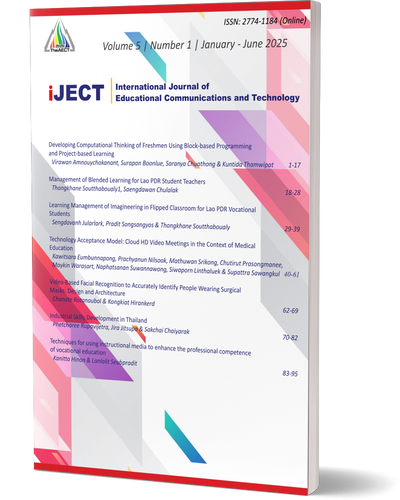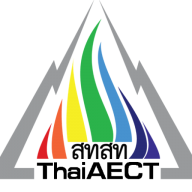Communication Model for Knowledge Management and Skill Development for Students with Learning Disabilities at Surin Province
Keywords:
Communication , Knowledge Management, Skill DevelopmentAbstract
This study is Communication Model for knowledge management and skill development for students with learning disabilities at Surin Province. The objectives were: (1) To develop a communication model for knowledge management aimed at enhancing the skills of students with learning disabilities in Surin Province. (2) To develop a learning kit for skill development tailored to students with learning disabilities in Surin Province. (3) To study the perceptions and practical applications by teachers, school directors, educational supervisors, and education personnel in Surin Province. The research process consists of three phases: Phase 1: Development of a Knowledge Management Communication Model. This phase involves collecting data through interviews, observations, and related documents. The data is synthesized using triangulation methods to construct a knowledge management communication model. Phase 2: Development of Learning Modules. The content is synthesized and creative learning materials are developed, including narrative articles, infographic illustrations, and videos. These materials are disseminated through knowledge exchange activities. Phase 3: Data Collection on Perception and Utilization Data is gathered from a sample group comprising 623 participants, including teachers, school principals, educational supervisors, and education personnel in Surin Province. Data collection is conducted using both closed-ended and open-ended questionnaires, with analysis through descriptive statistics, such as mean, standard deviation, and inferential statistics.
The results revealed that: Communication and Knowledge Management Model 3WCE for Developing Skills of Students with Learning Disabilities in Surin Province. The Development of a Learning Package for Skill Development of Students with Learning Disabilities in Surin Province. The process of communication for knowledge management in this study involved collecting and synthesizing data from various sources, including interviews with teachers, school administrators, parents, and students at Ban Nong Ka School in Surin Province, as well as relevant documents. The collected information was used to develop narrative articles, infographic illustrations, and videos by 3P (Pre-Pro-Post Production). The perceptions of knowledge management communication among 623 participants revealed the following: Perceptions from Media: The highest level of perception was achieved through video media, with a mean score of 4.57 (SD = 0.71). Perceptions of Practical Skill Instruction: Rank 1: Teachers demonstrated tasks repeatedly from start to finish, with a mean score of 4.89 (SD = 0.33). Perceptions of Student Skill Development Rank 1: Development of motor skills (e.g., coordination of body parts), with a mean score of 4.82 (SD = 0.44). Perceptions of Learning Factors for Students with Learning Disabilities: The highest-rated factor was the role of parents in skill development for students with learning disabilities, with a mean score of 4.78 (SD = 0.46). The perceptions of teachers, school principals, educational supervisors, and education personnel in Surin Province revealed statistically significant differences (p < 0.05) in their engagement with different types of materials: reading narrative articles, viewing infographic illustrations, and watching videos. Additionally, there were statistically significant differences (p < 0.05) in their understanding and perception of teaching practical skills based on Woodruff's model and the instructional methods for practical skills. This included detailed and clear demonstrations by teachers during instructional sessions. Teachers can apply training methods to enhance student learning, trust-building, and daily life skills. Creating a safe learning environment boosts student confidence and support, implementing support systems for students' emotional well-being and addressing at-risk behaviors. PLCs help teachers exchange ideas and improve their teaching methods. And Inclusive education and community engagement improve learning outcomes and create a safer school environment.
References
Kittima Jaipluem, & Team. (2020). Knowledge management for developing schools into learning organizations. Ramachulayanakorn Journal, 8(6), 46-60.
Ministry of Education. (2008). Basic education core curriculum 2008. Retrieved from http://academic.obec.go.th/web/news/view/75
Information and Communication Technology Center, Ministry of Education. (2024). Retrieved from https://edustatistics.moe.go.th/surin/#
Sorya Niyomtham. (2003). Characteristics and learning management for children with learning disabilities.
Academic Journal of Education, 4(2), 143-144.
Tisana Kaemanee. (2013). Teaching science: Knowledge for effective learning processes. Chulalongkorn
University.
Wanida Matbenanan. (2019). Academic Journal of Suvarnabhumi Institute of Technology, 8(2), 498-505.
Waritsanun Dechpanprasong, Mongkol Chaiyawong, Akkarawut Jindanurak, Trairat Pipatphokphol, &
Ploypapass Chitratson. (2022). Learning management model for developing students' practical skills.
Academic Journal of Suvarnabhumi Institute of Technology, 8(2), 428-440.
Pimphan Rattanachai. (2021). Promoting movement and social skills through integrated learning in schools.
Master's thesis, Chiang Mai University.
Subin Ekchit. (2018). Development of a video media for guidance on public relations regarding further
education at Suvarnabhumi Rajamangala University of Technology for grade 12 students. Master's
thesis, Faculty of Industrial Education, Rajamangala University of Technology Thanyaburi.
Chaisiri Phattathaworn, Busaba Suthithorn, & Sawanee Chinnalong. (2022). The use and satisfaction of online
media of the Office of Small and Medium Enterprises Promotion for entrepreneurs in Bangkok and
surrounding areas. Journal of Marketing and Management, Rajamangala University of Technology Thanyaburi, 9(1), 1-15.
Apinya Kaewpremkussol. (2018). Media acceptance, awareness, attitudes, and benefits derived from the
sufficiency economy philosophy of youth in Bangkok. Journal of Management Science, Nakhon
Pathom Rajabhat University, 6(2), 27-40.
Jiratchaya Vichianpanja, Oncharee Na Takhuatung, & Phromphak Buengbua. (2020). Development of
knowledge management systems for research utilization. Journal of the Research Association, 25(1),
-549.
Chulamas Jansreesuk. (2017). Learning management for children with learning disabilities. Udonthani:
Faculty of Education, Udon Thani Rajabhat University.
Thawisak Sirirattanreka. (2018). A Guide to Mental Health Care for Children with Learning Problems (2nd
ed.). Bangkok: Prosperous Plus.
Woravee Kaewmanna, & Dandutsit Proananon. (2022). Factors affecting the communication efficiency in
project management: A case study of the Accounting Profession Council under the Royal Patronage. Journal for Strategy and Enterprise Competitiveness I, 2(4), 48-66.
Sumalee Suwankorn. (2016). Creative communication strategies for developing Khon Kaen city. Master's
thesis, Graduate School of Local Administration, Khon Kaen University.
Educational Technology Office, Innovation for Learning, Thailand Institute of Scientific and Technological
Research (TISTR). (2022). Video Production Guide.
Chaisiri Phattathaworn, Busaba Suthithorn, & Sawanee Chinnalong. (2022). Using media for learning:
Concepts and development. Bangkok: University Press.
Thairath Online. (n.d.). LD children or learning disabilities: An important issue not to be overlooked.
Retrieved January 17, 2025, from https://www.thairath.co.th/lifestyle/health-and-beauty/2805502
Anon Chutisakun. (2019). Determining sample size with a ready-made table. Retrieved from
https://www.thetsis.com/post/research-tips-sampling
Nalinaorn Nuayplod. (2023). Investigating the effectiveness of video lessons in developing scientific thinking
skills of students. Journal of Education and Learning Innovation, 3(3), 227–239. Retrieved from
https://so06.tci-thaijo.org/index.php/jeil/article/view/264864
Sumitra Rojanniti, Boonman Thanasutphawet, & Nittaya Suwansri. (2022). Learning management in schools
for children with LD. Valaya Alongkorn Review (Humanities and Social Science), 12(2), May-August
Peng, W. (2015). Analysis of new media communication based on Lasswell's "5W" model. Journal of
Educational and Social Research, 5(3), 245-250.
Kolb, D. A. (2005). Experiential learning: Experience as the source of learning and development. Pearson
Prentice Hall.
Mayer, R. E. (2009). Multimedia Learning (2nd ed.). Cambridge University Press.
Piaget, J. (1952). The Origins of Intelligence in Children. International Universities Press.
Rogers, E. M. (1973). Communication Strategies for Family Planning. Free Press.
Schon, D. A. (1983). The Reflective Practitioner: How Professionals Think in Action. Basic Books.
Simpson, G., & Brown, J. (1977). [Title of the Work]. [Publisher]. [Page Number].
Vygotsky, L. S. (1978). Mind in Society: The Development of Higher Psychological Processes. Harvard
University Press.
Warisanan, D., & K. (2022). Learning management model for developing students' practical skills.
Srisailaun, O., & Jungpanich, A. (2015). Effects of using daily care plan video teaching on clinical self-
confidence and satisfaction of nursing students, Kuakarun Faculty of Nursing, Navamindradhiraj
University. Kuakarun Journal of Nursing, 22(1), 17-34.
Downloads
Published
How to Cite
Issue
Section
License
Copyright (c) 2024 International Journal of Educational Communications and Technology

This work is licensed under a Creative Commons Attribution-NonCommercial-NoDerivatives 4.0 International License.







